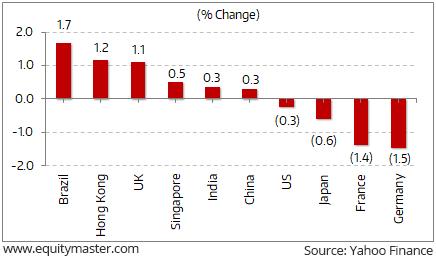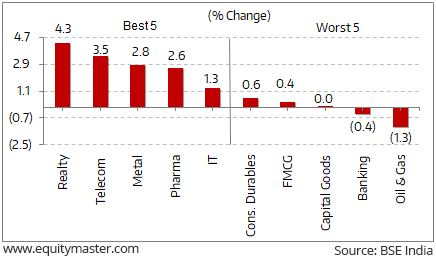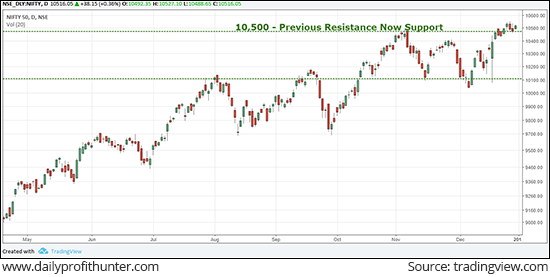
Global stock markets ended the final trading week of the year on a mixed note. Benchmark indices in US ended their best year since 2013 on a quiet note as technology and financial stocks kept equities in the negative territory for the week.
Major indexes in the US hit a series of record highs in 2017, lifted by a combination of strong economic growth, solid corporate earnings, low interest rates and hopes for a tax cut from U.S. President Donald Trump's administration. US stocks ended the week marginally lower by 0.3%.
In a quiet, week, major European indexes except the UK index ended in red as few fresh catalysts seemed to meaningfully shift market sentiment. Meanwhile, in the UK the FTSE100 ended 2017 on a new record high after a strong performance by index stocks.
Stock markets in Asia too were mixed with benchmark indices in Hong Kong and China surging by 1.2% and 0.3% respectively, while the index in Japan ended the week lower by 0.6%.

Back home, benchmark indices in India logged marginal gains of 0.3%, as a spurt in pharma stocks propelled the BSE Sensex to close the year above 34,000 levels.

Now let us discuss some key economic and industry developments during the week gone by
In news from energy sector. Road Transport and Highways Minister Nitin Gadkari has said that the government think-tank Niti Aayog is working on a policy to bring down the annual oil import bill by US$100 billion by the year 2030 through extensive use of methanol in cooking gas and transportation fuel.
He also said that the government will be soon announcing a policy which calls for 15% blending of methanol in petrol and will also reduce the cost of the fuel by 10%. Besides, he noted that India is the world's third-largest oil importer and the government has been making efforts to bring down imports by using methanol as an alternative fuel.
Besides, he said that use of methanol can result in great environmental benefits and its extensive use can reduce consumption of diesel by at least 20% in next 5-7 years. He noted that 20% blending of methanol with cooking fuel LPG will be low hanging fruit as it would result in immediate savings of Rs 60 billion a year.
Moving on to news from the economy. Ratings agency, ICRA sees India's current account deficit doubling to 1.5% of GDP by March 2018.
In a report, ICRA said that rising commodity prices - especially that of crude oil that has hit a three-year peak last week - will double the current account deficit (CAD) to US$ 39 billion or 1.5% of GDP this fiscal year.
In September, the domestic rating agency had pegged CAD which is the difference between inflows and outflows of foreign exchange based on the sale of merchandise, services and remittances, at 1.3% of GDP.
The widening merchandise trade deficit will lead to a deterioration in CAD to around between US$ 12 billion and US$ 15 billion. This translates to 2% to 2.3% of the GDP in the December quarter. However, seasonal factors will help the CAD shrink sharply to under US$ 5 billion for the March quarter, settling for a yearly deficit of 1.5% of GDP, at US$ 39 billion.
Expectations of widening of merchandise trade deficit is largely due to the high prices of commodity imports, and that the deficit is expected to be in double- digits for the third straight month in December despite help from rising exports.
A widening CAD will put pressure on the government's fiscal deficit target. In last one decade India is making serious efforts to reduce the fiscal deficit level. Ever since, the new government came in it has been in favor of fiscal consolidation and meet the long term fiscal deficit target of 3% by FY17-18.
Mind you, the recent demonetisation has resulted in a slowdown. Further, government has announced flurry of projects but execution is still pending. This means the government needs to relax its spending to spurt the growth again.
This means, once again, the government needs to fight dual challenge. First, maintaining its stance on fiscal consolidation and sticking it fiscal deficit target of 3% of GDP for FY17-18. Second, it must relax the deficit target for reviving the economy from the shock of demonetisation.
In the news from the banking sector, as per an article in the Economic Times, the government is likely to immediately infuse about Rs 100 billion in six state-run lenders over the next few weeks.
As per a finance ministry official, these six lenders are under stress and immediate infusion is to help them maintain the required regulatory capital.
The amount for the above plan will come from the Indradhanush Plan, where around Rs 180 billion is still left to be utilized.
The six banks who will get the above infusion are Bank of India, Indian Overseas Bank, Dena Bank, Corporation Bank, Central Bank of India, IDBI Bank, UCO Bank, United Bank of India, Bank of Maharashtra and Oriental Bank of Commerce.
The government, as a part of its Indradhanush Plan to revitalise state-owned lenders, had proposed to infuse Rs 700 bn out of Budgetary Allocations in them. However, so far, it has infused Rs 518 bn in public sector banks (PSBs).
Note that the government, in October, also announced the recapitalisation plan to inject Rs 2.11 trillion into public sector banks over a period of two years. This move was mainly aimed at resolving the long standing non-performing assets (NPA) problem of PSBs. It is expected to shore up the capital of state-run banks, spurring them to clean up the bad loan mess and revive lending.
The implementation of this initiative will, however, take some time. As a recent edition of The 5 Minute WrapUp states...
So, while recapitalisation will benefit PSBs, it appears to be a temporary cure for a recurring disease. The main problem is the lending and corporate governance processes these banks follow.
In the news from the macroeconomic front, as per an article in the Economic Times, as per a finance ministry announcement, India will borrow an additional Rs 500 billion this fiscal year.
The above borrowing comes as a negative development as it could breach the fiscal deficit target for the first time in four years and also weigh on bond and equity markets in India.
This additional borrowing could raise the fiscal deficit to 3.5% of gross domestic product (GDP), higher than the stated target of 3.2%.
The government has budgeted spending of Rs 21.5 trillion in FY18. Of this, it had spent Rs 12.9 trillion by October with a fiscal deficit of Rs 5.25 trillion against a full-year fiscal deficit budget of Rs 5.47 trillion. And this has led to fiscal slippage concerns this year.
One must also note that in the last one decade, India is making serious efforts to reduce the fiscal deficit level. Ever since, the new government came in it has been in favor of fiscal consolidation and meet the long term fiscal deficit target of 3% by FY17-18. This will be the lowest target compared to the last couple of years. That said, challenges remain in achieving the above stated target. The notebandi exercise resulted in a slowdown. Further, government announced flurry of projects but execution is still pending. This means the government needs to relax its spending to spurt the growth again.
This means, once again, the government needs to fight dual challenge. First, maintaining its stance on fiscal consolidation and sticking it fiscal deficit target of 3% of GDP for FY17-18. Second, it must relax the deficit target for reviving the economic growth from the shock of demonetisation.
It is also worthwhile to note that creating economic growth by the government spending its way out of trouble, cannot continue indefinitely.
As Vivek Kaul writes in one of his recent editions of the Vivek Kaul's Diary... 'At the end of the day the government has a limited amount of money at its disposal. Further, its expenditure tends to be terribly leaky and does not reach a major portion of those it is intended for.'
It would be interesting to see how the government tackles the above challenges. We'll keep you updated on the developments from this space.
In other news, the Lok Sabha has approved a bill to hike cess on luxury vehicles from 15% to 25%.
This is done with a view to enhance funds to compensate states for revenue loss following the rollout of the Goods and Services Tax (GST).
The above bill seeks to replace the Ordinance which was issued in September to give effect to the decision of the GST Council and provides for a hike in the GST cess on a range of cars from mid-size to hybrid variants and the luxury ones to 25%.
Automobile manufacturers may face some hiccups on the back of above development. Meanwhile, we'll keep you posted on the recent developments from this space.
| Top Gainers During the Week (BSE Group A) | ||||
|---|---|---|---|---|
| Company | 22-Dec-17 | 29-Dec-17 | Change | 52-wk High/Low |
| Reliance Communications | 16.31 | 36.22 | 122.1% | 42/10 |
| JAYPEE INFRATECH | 15.34 | 23.94 | 56.1% | 25/7 |
| JAIPRAKASH ASSO | 18.40 | 26.00 | 41.3% | 30/7 |
| JAIPRAKASH POWER | 6.97 | 9.52 | 36.6% | 10/4 |
| UNITECH | 7.62 | 9.64 | 26.5% | 10/`4 |
| Top Losers During the Week (BSE A Group) | ||||
| SYNDICATE BANK | 84.50 | 79.90 | -5.4% | 96/61 |
| IOC | 410.20 | 388.40 | -5.3% | 463/321 |
| ANDHRA BANK | 61.25 | 58.15 | -5.1% | 76/47 |
| ALLAHABAD BANK | 77.15 | 73.40 | -4.9% | 93/59 |
| PIDILITE INDUSTRIES | 945.15 | 902.55 | -4.5% | 972/588 |
Some of the key corporate developments in the week gone by
Moving on to the news from the bank stocks. As per an article in a leading financial daily, State Bank of India is planning to raise capital worth Rs 80 billion through additional tier-I bonds (AT1 bonds) by March 2018.
Reportedly, the board of directors of the bank has given a nod to raise additional tier-I capital (AT1) of Rs 80 billion through Basel-III-compliant debt instruments.
The lender has an option to issue bonds, in domestic and international markets in rupee and US dollar including masala bonds, till 31 March 2018. The bank could also issue masala bonds to international investors for raising AT1 capital.
Masala bonds are rupee-denominated specialised debt instruments that can be floated in overseas markets only to raise capital.
One shall note that, banks in India have to comply with the global capital norms under Basel III by March 2019, three months later than the internationally-agreed time frame, by January 2019.SBI's capital adequacy ratio (CAR) was 13.6% at the end of September 2017, with common equity tier-I at 10.2% and AT1 level of just 0.7%.
In news from the IPO space. According to Livemint, biscuits maker - Anmol Industries Ltd plans to list in 2018 and has begun work on an initial public offer (IPO). The company plans to file offer documents with the regulator soon.
The Kolkata based company has already appointed bankers for the process and plans to raise over Rs 10 billion through the offer, which would see the company valued at about Rs 40-50 billion.
The company has a turnover of over Rs 12 billion and sells over 30 variants of biscuits, cakes and cookies through over 2500 distributors. It also exports a range of biscuits to countries in Asia, Africa, Europe, the Middle East and the Caribbean Islands.
Several food and beverage companies have tapped the IPO market in the last few years in order to raise funds, retire debt and allow exits to private equity investors.
These include Indore-based Prataap Snacks Ltd, which sells potato crisps and a variety of savouries under the brand name Yellow Diamond which recently raised over Rs 4.8 billion.
Kraft paper manufacturer Astron Paper & Board Mill made a spectacular debut on stock exchanges during the week.
The script of the company got listed at Rs 114 apiece on BSE, a premium of 128% against the issue price.
The IPO of the company was oversubscribed by around 243 times.
Astron Paper is engaged in manufacturing of kraft paper and has its manufacturing facility in Gujarat with an installed capacity of 96,000 million tonnes per annum (mtpa).
Speaking of IPOs, the demand for IPO's has reached sky-high levels this year. Avenue Supermarts was the first company this year to cross the 100-time subscription mark swiftly followed by CDSL and Dixon technologies.
This euphoria is something similar to what was seen in 2007-08. When everyone around you is clamoring to get a piece of the IPO pie, it makes sitting tight difficult. And, why should you sit tight when stocks like Avenue Supermart lets you pocket a cool 100% gain from day 1 of the listing?
History suggests that these cases are few and far between. More than 70% of the IPOs listed in 2007 and 2008 are in the red, even today when the Sensex is at an all-time high.
A merit-based selection primarily including valuation, business, and management quality is the logical way to go about investing in IPOs. If it means going against the herd, so be it. And going by recent past, this strategy has been proven to be successful more often than not.
To know more, you can download our FREE report - How to Get Rich with IPOs. This guide will show you how to safely profit from the 2017 IPO rush.
According to a leading financial daily, both IOC and BPCL have separately indicated to the petroleum ministry their interest in taking over GAIL to help add natural gas transportation and marketing business to their kitty.
The merger options were indicated following FM Arun Jaitley's announcement in the 2017-18 Budget speech on the government's plan to create integrated public sector oil majors that will be "able to match the performance of international and domestic private sector oil and gas companies".
Despite the interest from the oil majors, GAIL feels a merger with oil and gas producer would be more appropriate.
ONGC is currently in the process of acquiring the government's 51.1% stake in HPCL, for over Rs 300 billion at the current market price.
IOC and BPCL gave separate options for the integration. The government's 55% stake in GAIL is currently worth about Rs 467 billion. Integration options suggested by other companies would be taken up only after ONGC-HPCL merger is complete.
This week, the Indian stock markets ended its December futures and options (F&O) expiry. Let's have a look at how the Nifty 50 Index performed during the expiry.
It was an exciting one for the Indian indices. At the start of the expiry, the bears had an upper hand where the index slipped to hit a low 10,033. Mid-expiry, the index recovered smartly to trade near 10,300 level.
The Gujarat and Himachal Pradesh election results brought in a sharp volatility, where the index gapped down 70 points and plunged to a low of 10,075. It acutely recovered on the same day to reach a high of 10,443. Post that, the index stabilised and traded with a positive bias to end the December series with 2.5% gains.
Last expiry, we mentioned that the 10,000 - 10,100 zone is an important support zone for the index. As a result, it triumphed from that level twice. Now the index has broken above its important resistance level of 10,500 (which will now act as a good support as per the change of polarity principle).
So does this mean that the index has resumed its upward graph after nearly three month of sideways trading?
The derivative and rollover data can give us some clue about this. You can look out for the detailed analysis on the derivatives data in today's Profit Hunter Pro newsletter (Subscription required). You can read the detailed market update here...

For information on how to pick stocks that have the potential to deliver big returns, download our special report now!